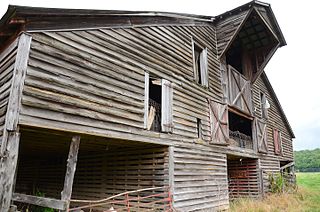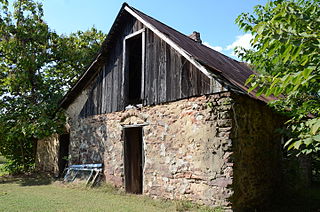Morris House or Morris Farm may refer to:
The Stack Barn is an unusual and historic barn in Benton County, Arkansas. It is located near Monte Ne about 500 feet (150 m) south of Arkansas Highway 94 1.5 miles (2.4 km) east of its junction with the spur route of AR 94 leading to the old Monte Ne resort area. Built in 1901, the barn's features are an amalgam of styles found from Pennsylvania to the American South. It is rectangular in shape, with a tin gabled roof that has a slight projection near the top at one end, and board-and-batten siding. Unlike typical Arkansas barns, it is set on slope with a stone foundation, creating a bank barn with an accessible basement more typical of northeastern barns, and necessitating a proper floor for the main level. The interior is laid out like a fairly typical 19th-century midwestern three-portal barn.

The Clarence Anderson Barn is a historic barn on the north side of Arkansas Highway 66 in the hamlet of Newnata, Arkansas. It is a two-story wood-frame structure, with vertical board siding and enclosed sheds on the side. The interior is organized in a transverse crib manner. Built in 1925, the building is distinctive for the pair of gable-roof dormers placed near the ridge line; this sort of feature is not usually found on barns in the region.

The John Avey Barn is a historic barn in rural western Stone County, Arkansas. It is located in the hamlet of Big Springs, on the north side of County Road 87 near the junction with Rosebud Road. It is a gambrel-roofed timber-frame structure, with vertical board siding. Built in 1906, it is the only documented bank barn in the county, with ground-level entrances on both levels. The southern end provides access to the lower level, while the upper level is accessed via an entrance on the north end.
The Davis Barn is a historic barn in rural Stone County, Arkansas. It is located on the west side of Bob Davis Mountain Road southwest of Pleasant Grove and Mill Creek. It is a single-story wood-frame structure, built on a double crib plan. It has vertical board siding, and an unusually wide driveway between the cribs. Built in 1915, it is a rare 20th-century example of the double crib form, which was more commonly executed in log construction in the 19th century.

The William Dillard Homestead is a historic homestead property in rural northeastern Stone County, Arkansas. It is located on the Round Bottom area northeast of Mountain View, on a plateau above the river's flood plain. It consists of two log structures, both now used as barns, that were built c. 1837, and are the oldest standing structures in the county. A single-pen log cabin stands on rough stone piers, and is covered by a gable roof. The walls are rough-hewn logs, joined by V notches. A shed-roof ell extends on the southern side of the structure, and more modern box-constructed sheds are attached to the north and east sides. A double crib barn stands across the road from the cabin.

The Orvall Gammill Barn is a historic barn on the northeast side of Stone County Road 87 northwest of Big Springs, Arkansas. It is a two-story structure, built out of a combination of logs and timber framing, with a gable roof, the gable oriented toward the road. It is built in a transverse crib pattern, with a series of log cribs fashioned out of hand-hewn logs joined by V notches, with a wood-framed loft area above. A shed addition extends along the building's north side. It was built in 1922 by Orvall Gammill and is locally unusual due to its transverse crib form being executed in logs rather than lumber framing.
The Binks Hess House and Barn are a historic farm property in Marcella, Arkansas. Located just east of Arkansas Highway 14 on Partee Drive, it is a 1+1⁄2-story dogtrot house, with a side gable roof, weatherboard siding, and a stone pier foundation. A single-story porch, supported by square posts, stands in front of the open breezeway section, which is finished in flushboarding, at the center of the east-facing main facade. An ell extends to the rear. Behind the house stands the barn, built on a transverse crib plan with side shed-roof additions. Both house and barn were built about 1871 for Binks Hess, brother of Marcella's founder Thomas. The barn is believed to be the oldest in Stone County, and the first to use sawn lumber in its construction.

The Thomas E. Hess House is a historic house on Arkansas Highway 14 in Marcella, Arkansas. It is a two-story I-house, five bays wide, with a side gable roof, weatherboard siding, and stone foundation. A two-story porch extends across the middle three bays of the north-facing front facade, with some jigsaw decorative work and turned balusters. An ell extends to the rear, and the rear porch has been enclosed. The house was built in 1900 by Thomas E. Hess, grandson of William Hess, the area's first white settler. Other buildings on the property include a barn, stone cellar, and a log corn crib that was originally built as a schoolhouse.

The Fred Lancaster Barn is a historic barn in rural eastern Stone County, Arkansas. It is located in the Round Bottom area northeast of Mountain View. It is a traditional-format four-crib log structure with a tall gable roof. Each of its cribs measures about 12 by 20 feet, and are divided by crossing driveways. The barn was built in 1918 by Fred Lancaster, and represents a transition from the traditional style crib barn to one with a transverse layout.

The H.S. Mabry Barn is a historic barn in rural central Stone County, Arkansas. It is located on the north side of County Road 21, south of Mountain View. It is a large two-story wood-frame structure, built in a transverse crib plan with animal stalls flanking a central drive that parallels the ridge of the gabled roof. Sheds extend the covered area on each of the long sides. The barn was built c. 1922 by Albert Hubbler to house H. S. Mabry's mule herd, and is noted for its unusually large size.
The Sam Cooley Barn is a historic barn, located just outside Bald Knob, Arkansas south of Collins Road. It is a two-story frame structure in a transverse crib configuration, with a metal roof, vertical board walls, and a stone pier foundation. Its main drive is oriented east–west, with the main vehicle entrance on the west, topped by a sliding door at the second level to allow tall equipment into the barn, and an animal entrance on the north side. Built about 1920, it is one of the best-preserved barns of that period in White County.

The Pinky Pruitt Barn is a historic barn on the south side of Arkansas Highway 14, just west of St. James, Arkansas. It is a single-crib structure 1+1⁄2 stories in height, built out of rough-hewn logs, with a stone pier foundation. It is surrounded on three sides by open sheds supported by log posts. It was built about 1890, and is reflective of the earliest form of barn built in Stone County by arriving settlers.
The Morris Hartsell Farmstead is a historic farm property in northern White County, Arkansas. Located on the north side of Arkansas Highway 157 in the hamlet of Steprock, it has one of the finest assemblages of 19th century farm buildings to be found in the county. Its main house is a single-story double-pen structure with a gable roof and a massive stone chimney at one end. One pen is built out of hand-hewn logs, while the other is framed in dimensional lumber. The second pen dates to about 1880, and the building has been little changed since then. Also included on the property are an equipment shed, and a large timber-framed barn, both of which appear to date to the same time.

The Hoofman Farmstead Barn is a historic barn in rural White County, Arkansas. It is located north of Searcy, on the west side of Salem Church Road. It is a stone structure, 1+1⁄2 stories in height, with a wood-frame gabled roof. It is basically rectangular, with a stone shed-roof extension on one side, giving it a saltbox profile. Built about 1920, it is the largest and possibly oldest historic stone structure in the county. It was built to serve as a large root cellar.

The Martindale Corn Crib is a historic farm outbuilding in rural northern White County, Arkansas. It is located west of Letona, in a field near a barn on the south side of Arkansas Highway 310. The corn crib is a small single-story wooden structure, built out of plank framing on a stone pier foundation, with a gabled metal roof on top. Built in 1924, it is a rare surviving example of post-and-nailer construction, in which the wall studs are stabilized by a horizontal member halfway up their length.
The Morris Institute Dairy Barn was a historic barn in rural White County, Arkansas. It was located on the campus of the Morris Institute, northwest of Searcy off Arkansas Highway 320. It was a two-story wood-frame structure, with a gable roof that was extended over a single-story extension on one side. Its internal arrangement was unusual, with a central drive that was intersected at one point by another drive extending into the shed section. Built about 1930, it was the county's best example of a Depression-era dairy barn.

The Seward Mansion is a historic house at 30 Flanders Road, in Turkey Brook Park, Mount Olive Township, Morris County, New Jersey. The mansion, described using its historic name, Seward House, was added to the National Register of Historic Places on December 24, 2013, for its significance in architecture.

The Anthony–Corwin Farm is a historic farmhouse located at 244 West Mill Road near Long Valley in Washington Township, Morris County, New Jersey. It was added to the National Register of Historic Places on May 1, 1992, for its significance in architecture. The 11.5-acre (4.7 ha) farm overlooks the valley formed by the South Branch Raritan River. The farmhouse is part of the Stone Houses and Outbuildings in Washington Township Multiple Property Submission (MPS).

The Leonard Neighbor Farmstead is a historic house located at 177 West Mill Road near Long Valley in Washington Township, Morris County, New Jersey. It was added to the National Register of Historic Places on May 1, 1992, for its significance in architecture. The farm overlooks the valley formed by the South Branch Raritan River. The house is part of the Stone Houses and Outbuildings in Washington Township Multiple Property Submission (MPS).














